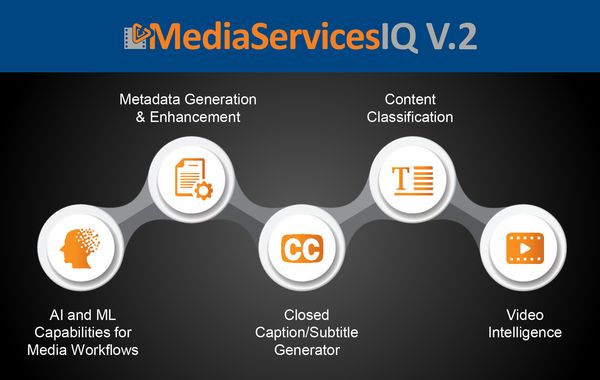
The amount of money that broadcasters and media and sports organizations spend on producing and acquiring content is massive. According to Industry Research, the size of the video production services market was valued at around $30 billion in 2021, and is expected to reach almost $50 billion by 2027.
Given the high cost of acquiring content rights, media companies need to repurpose their content as best they can to drive a return on investment, meet the growing consumer demand for content, and reduce unnecessary costs. The majority of broadcasters are sitting on a treasure trove of existing content that has the potential to be monetized.
Through our work with clients on content monetization at Newsbridge, we estimate that rights holders have the potential to generate $1 million in annual revenue per 10,000 hours of archived content. This article will explore how AI-powered semantic search technology is empowering media companies to examine petabytes of content in milliseconds, improving content monetization.
Key Content Discovery Challenges
Finding specific media assets within a vast archive with thousands or millions of hours of content is a significant challenge for media companies today. Traditional search engines within media asset management (MAM) systems have limited search capabilities and only support a set amount of custom metadata fields, which are generally filled in manually.
Multiple phrases can mean the same thing, leading to human error. For example, most MAM search engines are not intuitive enough to group the words “sneakers” and “trainers” together, and will only return results for the specific word that is searched.
While most MAM systems don’t currently utilize AI technology to optimize content searchability, those that do are provided as a gateway API and sourced from multiple vendors, making the use of AI for content discovery expensive. Moreover, AI services from third parties aren’t semantic or linked to the search engine, so it is impossible to actually find content. AI-powered semantic search technology must be more efficient, affordable, and capable of indexing media assets at scale.
Improving Content Search and Monetization With AI
By indexing content utilizing AI cognitive features, media companies can find what they are looking for in a matter of milliseconds. AI indexing and semantic search technology allow users to search for the clips with unparalleled speed and efficiency by merging detection results from face, text, objects, pattern, and transcription.
Over the next few years, AI indexing and search will become even more contextual, helping journalists identify the most relevant content clips. For example, one innovation on the horizon is AI indexing with natural language scene descriptions that allow broadcasters, TV channels, and other media users to instantly detect monuments (e.g., Eiffel Tower, White House), city landscapes (e.g., Paris at night), and natural landscapes (e.g., Niagara Falls, Uluru, Grand Canyon) within media archives for content repurposing and resell use cases.
The Football Association of Iceland is an example of a sports organization using cutting-edge broadcast and AI Indexing technologies to drive commercial revenue. Leveraging the latest AI Indexing technology, the association can automatically detect people, objects, logos, context and speech, for transcription and Icelandic-to-English translation. Facial recognition and optical character recognition are being used to automatically cut match and sponsor highlights.
The Next Evolution of Content Monetization
As content search technology and AI indexing technology advances, broadcasters are exploring new methods of monetization. The pinnacle for broadcasters, media companies, and sports organizations is making their archives available for purchase to external media partners and the general public via a feature commonly referred to as a storefront. The storefront acts like a self-serve archive, enabling any content that has been broadcast on-air to quickly be searched for and purchased for reuse.
French TV channel TF1 is an example of a media company that is effectively monetizing its archive. TF1’s media marketplace features auto-updating smart folders that enable the channel to keep its storefront constantly up to date with the latest daily news show recordings. Altice Media’s BFM TV, with its BFM Video marketplace that features more than 150,000 news and sport videos available for purchase, is another innovative use case. The platform is accessible by over 1000 buyers, including other news outlets from all over the world.
To be successful at offering a storefront, media companies need an advanced search engine that makes content highly visible and easily accessible. Moreover, media companies must create a standardized pricing model for storefront content. In the future, storefronts will be a game changer for the media industry, enabling rapid access to content archives and increased monetization.
An additional monetization option broadcasters and sports organizations are exploring is repurposing old video footage to create new content for OTT and FAST channels. Given the growing consumer demand for video and the high cost of production, some media companies are struggling to keep their TV channels running 24 hours a day. They are looking for cost-effective ways to repurpose old content, and with an optimized media archive that’s easily achievable.
In addition, a growing number of broadcasters, media and sports organizations, and content rights holders are selling iconic moments as non-fungible tokens (NFTs). NFTs offer consumers exclusive access to both new and archived media, such as behind-the-scenes footage, never-before-seen outtakes, and classic sporting match moments.
Ligue Nationale de Rugby (LNR) in France is a prime example of a sports league that is taking advantage of this modern business model. LNR uses an advanced Cloud Media Hub solution from Newsbridge to search through archived sports footage and clip all the best rugby highlights. The highlights are then resold as video NFTs, opening up a new revenue stream for LNR.
A decade ago, the term metadata was a buzzword in the media industry. But that is no longer true. With the rise of OTT and FAST channels, the consumer demand for content is at an all-time high and media companies are realizing the value that metadata brings to content.










